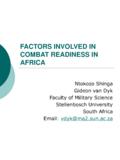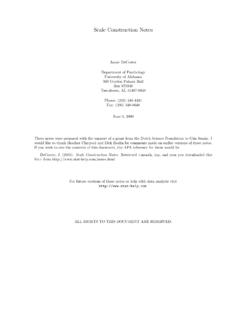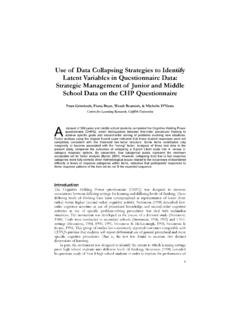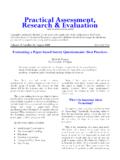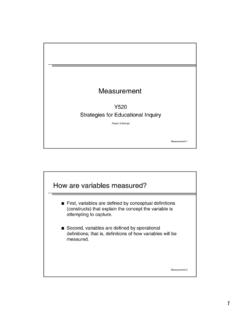Transcription of The Army Culture - Climate Survey
1 39th IAMPS Brussels 2003 Competencies for Crisis Response Operations 1 The Army Culture - Climate Survey Capt John Johnston LCol Peter Bradley Dr Danielle Charbonneau LT(N) Sarah Campbell The Royal Military College of Canada Introduction Background The research described in this paper is one of a number of studies sponsored by the Chief of the Land Staff to examine the organizational Culture of the Canadian Army. The aim of this group of Army Culture studies is to gather the information needed to meet one of the Army s strategic objectives -- shape Army Culture (Army Strategy, 2002). The focus of the study described in this paper is on obtaining a baseline measure of Army Culture as it is today. Purpose The research described in this paper has two objectives; (a) to provide a comprehensive description of the Army s Culture , and (b) to obtain information that will be useful to senior leaders as they develop policies to shape Army Culture for the future.
2 Distinguishing Culture from Climate Organizational Culture research has evolved from earlier work on organizational Climate . Organizational Climate is an established construct that has been studied since the late 1930s ( , Glick, 1985; Lewin, Lippitt & White, 1939; Schneider, 1972, 1975a,b). Schein (1992) describes Climate as members collective perceptions of their organization, which have an impact on behavior and the manifestation of the Culture of the organization. Studies of organizational Culture did not begin to surface until around 1980 ( , Dandridge, Mitroff & Joyce, 1980; Ott, 1989; Schein, 1984; Shriber & Gutek, 1987). Culture is normally defined as something deeper than Climate , identified in values, beliefs and assumptions held by organizational members (Denison, 1996). There is little argument about how to measure Climate ; however, there is much debate about whether Culture should be assessed with quantitative, qualitative or a combination of measurement methods.
3 These controversial issues will be discussed. Organizational Climate The study of organizational Climate is grounded in the theory of Kurt Lewin and colleagues who argued that behavior is a function of the person and the environment (B=f[P,E]; Lewin, Lippitt & White, 1939). Climate research has endeavored to explain the environmental variable. Many definitions of organizational Climate exist in the literature ( , 39th IAMPS Brussels 2003 Competencies for Crisis Response Operations 2 Litwin & Stringer, 1968; Moran & Volkwein, 1992). Schneider (1975) suggests that organizational Climate comprises perceptions that are psychologically meaningful environmental descriptions which people agree characterize a system s practices and procedures.
4 Campbell, Dunnette, Lawlor and Weick (1970) concluded that Climate has four fundamental dimensions, including individual autonomy, degree of structure, reward orientation, and a combination of consideration, warmth and support. The Agency Culture Questionnaire (ACQ; Schneider, 1972) suggests the existence of six dimensions: managerial support, managerial structure, concern for new employees, intra-agency conflict, agent independence and general satisfaction. These researchers and others have approached organizational Climate as a multi-faceted, organizational construct ( , Moran & Volkwein, 1992; Schneider, 1975; Ott, 1989); however, others see it as a set of more narrowly defined constructs such as safety Climate (Zohar, 1980, 2000), customer service Climate (Schneider, Parkington & Buxton, 1980), innovation Climate (Abbey & Dickson, 1983), and ethics Climate (Dickson, Smith, Grojean & Ehrhart, 2001).
5 Whether Climate is viewed as a multi-faceted or a narrowly defined construct, it has been linked to organizational performance (Franklin, 1975; Mudrack, 1989) as well as motivation and behavior (Decoitous & Summers, 1987; Lafollette & Sims, 1975; Litwin & Stringer, 1968; Pritchard & Karasick, 1976; Schneider & Snyder, 1975). Organizational Culture Schein (1990, 1992) conceptualized organizational Culture as the process of socialization that takes place to integrate individuals into an organization, and allow organizations to adapt to external demands. The essence of organizational Culture is the underlying values and beliefs that work to shape behavioral norms in organizations (Cooke & Lafferty, 1989; Kroeber & Klukhohn, 1952; Louis, 1983; Moran & Volkwein, 1992; Ouchi, 1981; Swartz & Jordan, 1980; Trice and Beyer, 1984; Uttal, 1983; VanMaanen & Schein, 1979).
6 Most definitions are derived from Schein (1992) who describes Culture as a pattern of basic assumptions that a given group has invented, discovered, or developed in learning to cope with its problems of external adaptation and internal integration, and that have worked well enough to be considered valid and, therefore, to be taught to new members as the correct way to perceive, think, and feel as related to those problems (Page 13). Culture has three distinct layers ranging from the observable rituals, symbols and behavioral norms at the artifactual level, to the less obvious espoused values and beliefs at the intermediate level, and finally underlying assumptions at the deepest, most subjective level of analysis (Denison, 1996; Rousseau, 1990; Schein, 1990, 1992). Although the impact of Culture on other organizational measures is somewhat unknown (Lawson & Shen, 1998), relationships with organizational strategy (Rousseau, 1990), job satisfaction ( , Allen & Dyer, 1980), and performance ( , Denison, 1984) have been demonstrated.
7 measurement of Organizational Climate and Culture The most appropriate assessment technique for organizational Culture is still the subject of debate. Glick (1985) contrasted organizational Climate with Culture and concluded 39th IAMPS Brussels 2003 Competencies for Crisis Response Operations 3that Climate research requires quantitative methods of measurement to describe and measure dimensions of the construct, while Culture requires qualitative techniques to explain processes that may underlie those dimensions. There is little disagreement that Climate is relatively salient (Schein, 1990), it operates at a level of awareness (Moran & Volkwein, 1992) and it can be reasonably well measured using interviews or paper and pencil measures and quantitative analysis techniques (Al-Shammari, 1992; James & Jones, 1974; Litwin & Stringer, 1968; Schneider, 1975).
8 On the other hand, the most appropriate means of measuring organizational Culture has yet to be agreed upon. Organizational Culture has been measured with qualitative and quantitative methods including, surveys ( , Hofstede, 1998), analytical descriptions ( , Trice & Beyer, 1984) ethnographic investigation ( , Barley, 1983), historical investigation ( , Pettigrew, 1979) and clinical description techniques ( , Schein, 1990, 1992). Early research on organizational Culture typically used qualitative methods; however, the use of quantitative methods is also supported ( , Rousseau, 1990; Xenikou & Furnham, 1996). A strong argument for using qualitative methods is based on the non-observable nature of Culture . For example Schein (1990, 1992) states that basic underlying, often unconscious, assumptions are the most important dimension of Culture , and accessible only through intense observation and focused interviews.
9 Another argument points out that organizations are unique; therefore, it would be unwise to assume any pre-conceived dimensional model of an organization s Culture , as all off-the-shelf surveys must do. On the other hand, those who support quantitative methods argue qualitative assessment is insufficient for organizational analysis (Xenikou & Furnham, 1996). They suggest measuring the level of consensus of organizational members on a set of practices and cognitive dimensions. Some researchers are now advocating a multiple method approach using both qualitative and quantitative methods (Reichers & Schneider, 1990; Rousseau, 1990; Schein, 1990, 1992; Xenikou & Furnham, 1996). Summary The literature suggests that organizational Culture and organizational Climate are separate but related constructs. Organizational Climate is accepted to be a temporary condition comprised of objective or perceived environmental issues that can be measured quantitatively, manipulated and changed relatively easily; whereas, organizational Culture is thought to be the set of values, beliefs and assumptions held in common by members of the organization and necessary for internal integration and adaptation to external forces.
10 Compared to Climate , Culture is more complex, difficult to assess and resistant to change. Organizations who want to assess their Culture must start by conducting a comprehensive qualitative analysis through ethnographic and clinical descriptive methods, to develop a conceptual model for their organization. When sufficient data are collected and a conceptual model is developed, quantitative analysis can be conducted to determine model fit. Focus of the Current Study The intent of this research is to develop a questionnaire suitable for measuring elements of Army Culture and Climate . We decided on measuring both Climate and Culture for two reasons. First, it is clear from our review of the literature that there is considerable overlap between Culture and Climate . Second, it was felt that a mix of Culture and Climate 39th IAMPS Brussels 2003 Competencies for Crisis Response Operations 4measures would be most useful given the practical requirement of this research to obtain information that will be useful to senior army leaders in policy development.
